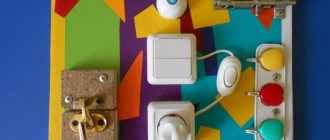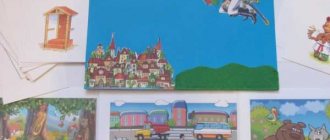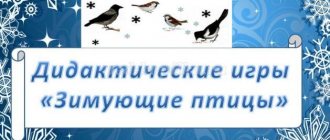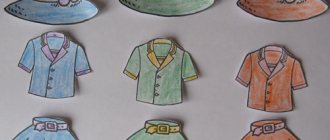Goal: to practically use didactic games and gaming techniques during speech correction work aimed at the most effective activation, clarification, and enrichment of the vocabulary of middle preschool children suffering from motor alalia.
Tasks:
— enrichment, clarification and activation of word formation in children's vocabulary;
– enrichment, clarification and activation of children’s verbal dictionary;
— enrichment, clarification and activation of the vocabulary of nouns in children;
- enrichment, clarification and activation of the vocabulary of adjectives in children;
- enrichment, clarification and activation of the numeral in children;
- learning to understand and use prepositions and particles in speech.
Didactic games and gaming techniques specially selected and developed by us
meet the tasks that are solved by the previously mentioned directions and methods of logocorrection work.
The set of games presented below offers gaming techniques for practical familiarization of children with the use of nouns in speech, introduces children to the concept of “word,” and teaches children to distinguish between the concept of “living” and “non-living.” At the same time, the game gives the speech therapist the opportunity to set an additional goal for himself, for example, grouping objects according to their characteristics or purpose, working on different types of meaning of a word (conceptual, situational, emotional). These games teach children to use the plural of nouns, distinguish the gender of nouns, and are also aimed at creating and consolidating generalizing concepts. These games also teach the use of case forms.
Who is this? What is this?
Goal: clarification, enrichment of word formation in children's vocabulary, teaching children to correctly use in speech words denoting living and inanimate objects.
Equipment: living or non-living objects. (Table, book, toys, birds, fish, etc.)
Game description:
The speech therapist addresses the children: “There are many different objects around us. And we can ask about each of them. I will ask you, and you answer me with a question: “What is this?” The speech therapist points to various inanimate objects: books, toys, table. “How can you ask about these items?” (What is this?)
The speech therapist says: “And now I’ll ask you differently: who is this?” The speech therapist points to living objects: a bird, a fish, a nanny, children - and asks the children: “how can you ask? (Who is this?) I will name you various objects, and you will ask me questions about these objects.” The speech therapist names living objects, and the children ask the question “who?” In this way, the speech therapist gradually leads children to the concepts of “living” and “non-living”.
The speech therapist puts a girl and a doll next to each other and asks how the girl differs from the doll. Children name the difference and together come to the conclusion that the doll is not alive, a toy, and the girl is a living creature. Next, compare the toy bear and the living bear drawn in the picture. It becomes clear that the bear toy is not alive, and the drawing depicts a living bear. To summarize, the speech therapist concludes: all words denoting inanimate objects answer the question “what?”, and words denoting living objects answer the question “who?”
Development and enrichment of vocabulary in preschool children
Bibliographic description:
Pavlova, I. Yu. Development and enrichment of vocabulary in preschool children / I. Yu. Pavlova.
— Text: direct // Pedagogical skills: materials of the I International. scientific conf. (Moscow, April 2012). - Moscow: Buki-Vedi, 2012. - pp. 212-215. — URL: https://moluch.ru/conf/ped/archive/22/1934/ (access date: 10/18/2021). Problems and tasks of speech development in preschool children have always been relevant. At all times, great attention has been paid to the development of children's speech. The importance of speech in the development of a child’s personality is so great that the tasks of its formation occupy a special place in education.
The word introduces a child to the world of people, helps to understand it and get used to it, helps to realize oneself as an individual and become an active participant in the life of society. The word is the child’s main means of communication and form of self-expression. It serves as a means of regulating his behavior. With the help of words, the child learns about the natural and objective environment.
In preschool age, a child must master a vocabulary that would allow him to communicate with peers and adults, study successfully at school, understand literature, television and radio programs, therefore preschool pedagogy considers the development of vocabulary in children as one of the important tasks of speech development.
A dictionary is the lexical composition of speech that a person uses. The dictionary is divided into active and passive. The volume of the active vocabulary of any person is less than the volume of the passive one.
The development of vocabulary during the normal development of a child is given in the table:
Quantitative growth of vocabulary according to Stern
| From 1 to 1.5 years | at 2 years old | at 3 years old | at 4 years old | at 5 years old |
| 100 words | 300-400 words | 1000 – 1100 words | 1600 words | 2200 words |
The data in the table shows that in preschool children, vocabulary development occurs especially quickly, like at no other age.
A special feature of a preschooler’s dictionary is its significantly smaller volume compared to an adult’s dictionary, since the volume of accumulated information about the environment is significantly inferior to the volume of knowledge of an adult.
For vocabulary development, constant communication between adults and children is important. The volume and quality (accuracy, imagery) of a preschooler’s vocabulary depend on how complete his communication is. Therefore, parents need to introduce their child to new objects, phenomena, and their names. It is important to talk with the preschooler, ask questions, and create situations in which possible shortcomings in the child’s understanding and use of words will be revealed. An active family lifestyle provides fertile material for expanding vocabulary: excursions to the theater, circus, zoo, etc.
As speech and thinking develop, the gradually expanding vocabulary is systematized, ordered, developing into semantic fields or formations of words united by meaning.
R.I. Lalaeva highlighted the following directions for the development of the dictionary:
- Dictionary expansion
- Clarifying the meaning of a word
- Development of the structure of word meaning
- Formation of semantic fields and lexical systematicity
- Expanding connections between words in the lexicon.
The method of speech development for preschoolers offers a type of activity that is structured in the form of a game. This facilitates the assimilation of material, develops auditory attention in children, and promotes correct speech perception.
Presenting material aimed at enriching the vocabulary in the form of a game teaches children to correlate a sound word with a picture or object, clearly pronounce simple and polysyllabic words, and answer questions.
The goal when conducting such classes is one: replenishment of vocabulary.
Teachers widely use didactic games, which not only allow for the comprehensive development of preschoolers, but also contribute to the development of vocabulary skills in children.
A didactic game is a multifaceted, complex pedagogical phenomenon: it is a gaming method of teaching preschool children, a form of education, an independent gaming activity, and a means of comprehensive education of a child’s personality. It is in didactic play that the child gets the opportunity to improve, enrich, consolidate, and activate his vocabulary.
Depending on the material, didactic games can be divided into three types: games with objects (toys, natural materials, etc.), printed board games and word games. It should be noted that all of these games can be successfully used to activate the vocabulary of preschoolers. Games with objects are most accessible to children, since they are based on direct perception, correspond to the child’s desire to act with things and thus get acquainted with them, in addition, the child willingly names the objects he sees.
The child begins to play these games at an early age and does not lose his interest in them throughout preschool childhood. In early preschool age, many games with toys are accompanied by movements, which corresponds to the characteristics of the child’s perception and thinking
The most complex are verbal games: they are not associated with the direct perception of an object; in them, children must operate with ideas. These games are of great importance for the development of a child’s thinking, since in them children learn to express independent judgments, draw conclusions and conclusions without relying on the judgments of others, and notice logical errors.
Verbal games are carried out mainly in older groups and are very important for preparing children for school, as they require and, therefore, develop the ability to listen carefully, quickly find the right answer to a question, accurately and clearly formulate their thoughts, and apply knowledge.
A didactic game as a form of teaching children contains two principles: educational (cognitive) and gaming (entertaining). The teacher is both a teacher and a participant in the game. He teaches and plays, and children, while playing, learn.
Game techniques for developing vocabulary in young children:
Game: "Cold - Hot."
Target:
Enriching your vocabulary with nouns
Content.
The adult asks the children to close their eyes, then hides the object and asks the question: “Where is the bear?” Children look for an object in the room at the prompt of an adult: “It’s cold. Colder. Warmer. Even warmer. Hot". A game of searching for a missing object helps children remember a new word.
Game: “Describe the object.”
Goals:
Expanding the vocabulary of adjectives, forming ideas about the subject.
Content.
An adult examines an object and points out its signs. For example, an adult examines an apple. It is yellow in color. The shape resembles a ball (it clasps the apple with the hands), the apple is round. It is large in size. If you stroke an apple, you feel that it is smooth. I press on the apple, nothing happens to it. The apple is hard. I’ll smell the apple: oh, how fragrant and fragrant it is. I’ll hold it in my hand and weigh it: the apple is heavy. I’ll cut a piece and taste it: the apple is sweet (sour, sweet and sour).”
Game "Wonderful bag"
Goals:
Expanding the volume of vocabulary, developing tactile perception, clarifying ideas about the characteristics of objects.
Equipment.
An elegantly decorated bag, small toys, the names of which belong to the same lexical group (“Dishes”, “Vegetables”, etc.)
Content.
First, children get acquainted with toys whose names belong to the same lexical group: they examine, name, and highlight their qualities. The first player puts his hand into the bag, feels for one toy, recognizes it and calls it: “I have a cup.” Only after these words can the child take the toy out of the bag, examine it and show it to all the children. If the answer is correct, the child takes the object for himself. Players take turns recognizing by touch, naming and removing objects from the bag. The one who collects the most toys wins.
Complicated version
(for older preschoolers): before taking an object out of the bag, it is required to determine its shape (round, oblong), the material from which the object is made (rubber, metal, rag, wood, plastic), the quality of the surface (smooth, rough, slippery) , cold).
Game “Mail”, “Decorate the Christmas tree”, “Magic tree”, “Thematic lotto”, “Dominoes”
Game "Parcel"
Goals:
Expanding the volume of the vocabulary, clarifying ideas about the characteristics of objects, developing coherent speech.
Equipment. Items, boxes according to the number of players.
Content. Each child receives a “parcel” (a box with an item inside). The first player begins to describe his item without naming or showing it. The item is presented after it is guessed.
Game "Analogies"
Goals:
Activation of nouns with a general meaning, development of understanding of generic relations between words (development of the conceptual component of the lexical meaning of a word)
Content.
The adult invites the children to complete the word according to the example: fox is an animal, crane is a bird, or vice versa. The adult names a word of general meaning, the child comes up with a word of specific meaning (or vice versa): dishes - frying pan, flowers - dandelion, transport - truck, fish - catfish, insects - grasshopper. The one who never gets lost wins.
Game "Edible - Inedible"
Goals:
Development of the ability to highlight the essential features of an object (edibility, animation, etc.), clarification of the meaning of generalizing words, development of auditory attention, general motor skills.
Content.
The presenter says the word and throws the ball to one of the players. If a food item, fruit or other edible object has been named, the player needs to catch the ball. Otherwise, the player dodges the ball. The games “Living - Non-Living”, “Vegetables-Fruit”, “Wild Animals - Pets”, “Birds - Insects”, “Clothes - Shoes”, etc. are played in a similar way.
Game "I Know Five..."
Goals:
Activation of words with a general meaning, development of understanding of generic relationships between words (development of the conceptual aspect of the meaning of a word).
Content.
Children stand in a circle. The first player, who has the ball in his hands, begins the game with the word: “I” and passes (throws) the ball to the child standing next to him. The second player receives the ball, says the following word: “I know,” and passes the ball on. Third player: "Five." The next child of the Insects. Then each move is accompanied by the naming of one insect until five words of this group are named. The game continues.
Ball game "Associations"
Goals:
Expansion of vocabulary, development of speech associations, general motor skills.
Content.
The adult throws the ball to the child and names a specific feature of the object: “Red.” The child catches the ball, adds a word denoting an object that has this attribute (mac0), and returns the ball to the adult. Similarly: heavy - truck; prickly hedgehog, cold snow, tall - man, glass - glass.
It is possible to conduct a game based on the material of a specific lexical topic (with or without support from pictures). In this case, the adult agrees with the child that he needs to come up with words on a certain topic (for example, on the topic “Dishes”). In this case, corresponding pictures can be presented on the typesetting canvas. Approximate lexical material: deep - plate; blue - pan; small saucer; transparent - jug.
Game “I collected in the garden...”
Goals.
Expansion of vocabulary, development of auditory memory.
Content.
The adult starts the game by saying the sentence: “I picked cucumbers from the garden.” The child repeats the entire phrase and adds the name of his vegetable: “I picked cucumbers and tomatoes from the garden.” The next player repeats everything said by the previous participant and comes up with a third vegetable: “I picked cucumbers, tomatoes and onions from the garden.” Players participate in the game until the first mistake. The winner is the one who remains in the game last. Depending on the lexical topic, the sentence changes in content: “I collected... in the garden,” “I put it in the closet...”, “I saw on the street...”, “He lives in the forest...”, “In the kitchen there is...” » etc.
Game “Say it with another word”
Goals.
Formation of semantic fields, expansion of the dictionary of synonyms.
Content.
An adult names a phrase and asks a question: “Throw the ball. How can this action be called differently, in another word?” Samples of correct answers are given: “Throw the ball - throw the ball. Looking out the window - looking out the window." Children begin to select synonyms only after confirming their understanding of the task.
Ball game "Say the opposite"
Goals.
Formation of semantic fields, expansion of the dictionary of antonyms.
Content.
Children stand in a line facing the leader. The adult (leader) says the word and throws the ball to one of the players. The person who catches the ball must name the antonym (the word “enemy”) to the given word and return the ball to the leader. If the paired word is chosen correctly, the child takes a step forward. The winner is the one who quickly approaches the conditional line on which the leader is located. This child continues the game by inventing his own words.
Literature:
- Alekseeva M.M., Yashina V.I. Methods of speech development and teaching the native language to preschoolers. – M.: 2000.
- Bondarenko A.K. Word games in kindergarten. – M.: 1974
- Borodich A.M. Methods for developing children's speech. – M.: 1981
- Kolunova L.A., Ushakova O.S. Work on words in the process of speech development of older preschoolers // Preschool education. 1994 No.9.
- Sokhin F.A. Speech development in preschool children. – M.: 1984
- Tikheyeva E.I. Children's speech development. – M., 1992
- Udaltsova E.I. Didactic games in the education and training of preschool children.-M.: 1976.
- Ushakova O.S. Speech development classes in kindergarten. – M.: 1993
- Ushakova O.S. Speech development of a preschooler. – M., 2001
- Ushakova O.S., Strunina E.M. The influence of vocabulary work on the coherence of speech // Preschool education. – 1981 No. 2.
- Elkonin D.B. Child psychology. – M., 1999
- Shvaiko T.S. Games and play exercises for speech development. – M.: 1983
Key terms
(automatically generated)
: child, game, word, object, vocabulary, ball, vocabulary expansion, adult, player, content.
Look at the pictures
Goal: to consolidate in children’s speech words denoting living and inanimate objects.
Equipment: subject drawings depicting living and inanimate objects, flannelgraph.
Game description:
The speech therapist puts all the subject pictures on the flannelgraph and asks the children to look at them carefully. After this, the speech therapist gives the following tasks:
1) name pictures depicting living objects, ask questions about them;
2) name pictures depicting inanimate objects, pose a question.
Complicating the game: the game is played without relying on drawings. The speech therapist selects different words (living and non-living) and names them mixed. Children should pose a question to these words. The most active ones are noted at the end of the game.
Vocabulary development in preschoolers through games
Using speech games with preschoolers with your own hands
Author: Utyuzhnikova Svetlana Sergeevna, teacher-speech therapist, MADOU d/s "Buratino", regional center of Kyra The word is the first sign of a conscious, intelligent life.
The word is the recreation of the world within itself. (K.S. Aksakov) Successful speech development depends on children’s perception of the world around them and on objective activity. I offer speech exercises that will be useful for teachers and children, all the illustrative material was drawn by ourselves, made in color using watercolors .In a playful way, preschoolers will get acquainted with word formation, learn to form new words, understand the meaning and origin of complex words, and identify related words.
Word formation means the formation from some words of other cognate words with a new semantic meaning. Goal: development of vocabulary in children; Objectives: - to teach to distinguish words that are “related” by their semantic meaning; - ensure an accurate understanding of the semantic meaning of learned words; -develop the simplest word formation skills; Equipment: do-it-yourself subject pictures;
Let's look at the simplest, most accessible ways for children to form new words. Options for games using pictures
Game “Big-Small” Purpose: to teach children the correct education and use of diminutive forms of nouns; Progress of the game: Children are shown pictures with large and small objects depicted on them and questions are asked based on these pictures, stimulating them to independently form words with the necessary diminutive suffixes. For each large object, choose the same one, but small. Name the small objects affectionately. For example: This is a big house. But what about a small one? (house);
House-house
There is a big ball in the picture. But what about the small one? (ball);
Ball-ball
What about the little mushroom? (mushroom);
Fungus mushroom
Game “Find relatives” The purpose of the game: to develop children’s ideas about related connected words, master the skill of selecting related words, clarify and activate vocabulary; Progress of the game: Lay out the pictures. Invite the children to name the pictures. Then ask for each picture to find a picture pair, which is called a related word. Select pairs of words according to their meaning, for example:
Tea-kettle
Leaf-leaves
Bread box
Snow-snowman
Sea-sailor
Fisherman fish
The picture will help you check the completion of the task. In order to establish the relationship of words, you need to understand them and be able to explain the meanings. Ask the children to make sentences based on the pictures. You can come up with sentences based on individual pictures or using pairs of related words.
Game “Word Formation” Guess the riddles. Find and name the answer pictures. Explain what words each guess word is made of. Here is a steel bird that aspires to the skies, And its pilot leads it. What kind of bird? (plane)
Beautiful wheels There are usually two of them. It also has a kickstand. What is this, kids? (samokat)
Hands on hips, like a boss, He gets up on the table before everyone else, He has his own stove and a kettle - He will brew it himself, he will pour it himself. (self-BAR)
We have a robot in our apartment, - It has a huge trunk, The robot loves cleanliness, And it hums like a liner: “Too-oo.” It swallows dust with great eagerness, But it doesn’t get sick, doesn’t sneeze... (dust SOS)
Game “Brother Words” Look at and name the pictures. Where is the boletus? Where is the boletus? How are these words similar to each other? Aspen trees grow in the aspen forest and reach for the blue sky. Under the aspen trees there are aspen mushrooms, Such beautiful mushrooms!
Birch groves are elegant and bright, Birch trees brought a lot of light with them. Birch trees are beautiful, growing in a birch forest, And that light birch forest goes down to the river.
Thus, the children got acquainted with word formation in a playful way, developed their vocabulary, it was interesting, educational and exciting.
We recommend watching:
Game - invention for senior and preparatory groups Didactic game for the development of speech in children 5-6 years old Lexical games “Living and inanimate objects” for preschoolers 4-7 years old Verbal game for preschool children for the development of phonemic hearing
Similar articles:
Games for the development of perception and speech in children 4-6 years old
DIY speech therapy games for preschoolers
DIY speech therapy games
Speech therapy game for older preschoolers
Speech therapy game for children 5 – 8 years old “Who is faster”
What did they hide?
Goal: enrichment, activation and clarification of word formation in children’s vocabulary and correct use of nouns in speech.
Equipment: dummies of vegetables, fruits, flowers.
Game description:
Flowers, vegetables and fruits are laid out on the table. (2-3 pieces) Children are asked to carefully examine what is on the table and remember what is where. Then the children turn away, and the speech therapist hides one object. The child must answer what is hidden. (You can answer in one word)
Name what I point to
Goal: enriching and activating the word formation of children’s vocabulary and teaching them the correct use of nouns.
Equipment: real and toy furniture.
Game description:
The teacher seats the children so that they can see individual pieces of furniture in front of them and asks them to name them. If this is difficult, the speech therapist himself names the object and invites one of the children to move, for example, a doll, to the sofa, etc. Then you can offer a riddle: “A boy came to kindergarten, sat down and invited another boy to sit down next to him. What were they sitting on? (On the bench, on the sofa)
Who will bring the items faster?
Goal: clarification and activation of word formation in children. Development of skills for classifying lexical topics “Vegetables and fruits”.
Equipment: dummies of vegetables and fruits.
Game description:
Players sit on chairs, 2 chairs are placed opposite them, 5-6 items from two different categories are placed on them: vegetables - carrots, cabbage, cucumber; fruits – apple, pear, cherry. Two empty chairs are placed at a distance. Two children from each team stand near the chairs with objects and at the signal: one, two, three - take the vegetables! - they begin to transfer the necessary objects to the empty chairs standing opposite. The winner is the one who transfers all the objects that belong to the named category more accurately and earlier and names them.
How do we dress?
Goal: activation of word formation with words on the lexical topic “Clothing”. Teaching the correct use of nouns in speech.
Equipment: items of children's clothing.
Game description:
Each child comes up with some item of clothing, for example, a scarf, a skirt, panties, a T-shirt, and quietly names it to the speech therapist so that other children do not overhear. (The teacher makes sure that the children do not choose the same thing) Then the teacher talks about something, for example: “Vasya was going sledding and put it on...” interrupting the story, he points to one of the participants in the game. He names the item of clothing he has in mind. Other children must judge whether the boy is dressed correctly.
What are vocabulary games for?
Work on the development of the lexical side of speech is an important part of the work of a speech therapist. The child must be able to understand and recognize various words, apply them correctly in sentences, and be able to talk with peers and adults. That is why in kindergarten there are classes on vocabulary development, of course, in the form of a game.
Here are the main areas of work of a speech therapist on vocabulary development:
- expansion of vocabulary in parallel with the expansion of ideas about the world around us, the formation of cognitive activity;
- developing the ability to find antonyms and synonyms;
- use of evaluation words;
- clarifying the meaning of words;
- development of independent statements;
- formation of word formation;
- formation of the semantic structure of the word.
Because learning takes place through play, children quickly learn new information. Vocabulary games allow a child not only to successfully master a vocabulary that would allow him to communicate with other children and with adults. They contribute to further successful learning at school and college. Developed vocabulary is important for building normal relationships with people. The development of a child’s vocabulary is associated with the development of thinking and other mental processes.







